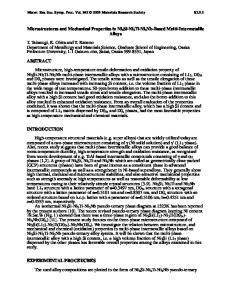Phase Stability and Magnetic Properties of E2 1 -(Co, Ni) 3 AlC Based Alloys
- PDF / 802,659 Bytes
- 6 Pages / 612 x 792 pts (letter) Page_size
- 28 Downloads / 353 Views
BB5.50.1
Phase Stability and Magnetic Properties of E21-(Co, Ni)3AlC Based Alloys Yoshisato Kimura1, Kaoru Iida2 and Yoshinao Mishima Materials Science and Engineering, Tokyo Institute of Technology, Yokohama 226-8502, JAPAN. 1 also Fellow of PREST, Japan Science and Technology Co., Kawaguchi, Saitama 332-0012, JAPAN, 2 Graduate student now with Konica Co., Tokyo, JAPAN. ABSTRACT Phase stability of E21 (Co, Ni)3AlC was investigated from the viewpoint of magnetic properties in the Co-Ni-Al-C quaternary system. Isotherms of the Co-Al-C and Ni-Al-C ternary systems at 1373 K were revised and evaluated by means of electron probe microanalysis. Magnetic properties measurement revealed that discontinuity appearing on the chemical concentration dependence of Curie temperature and saturation magnetization of E21 (Co,Ni)3AlC indicates the existence of two types of E21 phase in the Co-Ni-Al-C quaternary system. INTRODUCTION The E21 type intermetallic compound Co3AlC can be a very attractive strengthener of Co-base heat resistant alloys since the E21 type ordered crystal structure is almost the same as that of the L12 type, the ordered structure of Ni3Al being well-known as strengthener of Ni-base superalloys [1], excluding an interstitial carbon atom occupying the octahedral interstice at the body center [2-5]. In other words, missing “L12 Co3Al” in the Co-Al binary system was disadvantageous in the history of developing Co-base heat resistant alloys as compared to Ni-base superalloys since available strengthener was limited such as carbides. The E21 phases including Co3AlC were extensively investigated as cubic carbides in 1960’s [2,3], though there had been almost no work to investigate mechanical properties of E21 phases until 1990’s [4,5]. We have systematically conducted the design of Co-base heat resistant alloys strengthened by E21 Co3AlC, and revealed that the α-(Co)/E21/B2 three-phase alloys show compressive strength of 350 MPa at 1273 K and excellent ambient temperature ductility of exceeding 8% plastic strain in tension through specific microstructure modification by hot forging and annealing [6,7]. However, it is hard to obtain large volume fraction of E21 Co3AlC by precipitation in the α-(Co) matrix, and suitable alloy compositions are restricted by having to avoid graphite formation. Therefore we have planned on expanding the alloy system to the Co-Ni-Al-C quaternary in which E21 is reported to form a continuous solid solution [8,9]. On the other hand, many of E21 compounds exhibit ferromagnetism and draw much
BB5.50.2
attention as magnetic materials[10]. Phase stability and magnetic property generally have strong correlation through crystal structure, lattice size and atomic bonding. It is quite interesting to measure the magnetic properties of E21 phase to examine its phase stability. The objective of the present work is to investigate the phase stability of E21 (Co,Ni)3AlC from the viewpoint of magnetic properties. Final goal is to design and develop Co-base superalloys effectively using E21 (Co, Ni)3AlC p
Data Loading...











